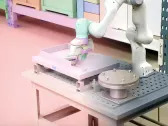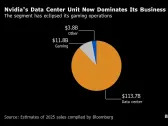Simulation of Robotic Arms in Factory Settings
NVIDIA’s Omniverse can simulate robotic arms in a factory setting, showcasing the potential of generative physical AI. This technology has far-reaching implications for industries such as manufacturing and logistics.
New Models and Frameworks Accelerate World Building for Physical AI
Creating 3D worlds for physical AI simulation requires three steps: world building, scenario creation, and data generation. NVIDIA’s Omniverse provides new models and frameworks that accelerate this process, enabling faster development of complex simulations.
NVIDIA NIM Microservices
NVIDIA NIM microservices are a suite of cloud-based services designed to streamline the development of AI applications. These microservices provide a flexible and scalable architecture for building and deploying AI models.
NVIDIA Edify SimReady Generative AI Model
The NVIDIA Edify SimReady generative AI model is a powerful tool for generating synthetic data used in simulation scenarios. This model can create realistic and varied scenarios, reducing the need for real-world testing and data collection.
NVIDIA CUDA-X
NVIDIA CUDA-X is a suite of tools and libraries designed to accelerate development of high-performance computing applications. CUDA-X provides a unified programming model for NVIDIA GPUs and CPUs, enabling developers to write applications that take advantage of both architectures.
NVIDIA Blueprints: Unlocking the Potential of Physical AI
NVIDIA Blueprints are pre-built templates and frameworks for developing AI applications. These blueprints provide a starting point for developers, allowing them to focus on customizing and fine-tuning their models rather than building from scratch.
Mega: Autonomous Warehouses and Robotic Fleets
Mega is a blueprint designed to help developers build autonomous warehouses and robotic fleets. This blueprint provides a comprehensive framework for creating complex simulation scenarios, enabling developers to test and optimize their AI models in a realistic environment.
Autonomous Vehicle Simulation
The Autonomous Vehicle Simulation (AVS) blueprint is a powerful tool for developing and testing self-driving cars. AVS provides a realistic simulation environment that includes detailed vehicle models, sensor simulations, and traffic scenarios.
NVIDIA Omniverse Spatial Streaming to Apple Vision Pro
NVIDIA’s Omniverse spatial streaming workflow enables developers to create immersive and interactive experiences using the Apple Vision Pro headset. This technology has far-reaching implications for industries such as architecture, engineering, and product design.
Katana Studio: Custom Car Configurators
Katana Studio is a company that used NVIDIA’s Omniverse spatial streaming workflow to create custom car configurators for Nissan and Volkswagen. These configurators enable customers to design and review car models in an immersive experience, improving the customer decision-making process.
Innoactive: XR Streaming Platform for Enterprises
Innoactive is a company that developed an XR streaming platform for enterprises using NVIDIA’s Omniverse spatial streaming workflow. This platform enables companies to conduct design and engineering project reviews at human-eye resolution, improving collaboration and productivity.
Syntegon: Digital Twins for Pharmaceutical Production
Syntegon is a provider of processing and packaging technology solutions for pharmaceutical production. They used NVIDIA’s Omniverse spatial streaming workflow to enable their customers to walk through and review digital twins of custom installations before they are built.
About NVIDIA
NVIDIA (NASDAQ: NVDA) is the world leader in accelerated computing. With a history of innovation, NVIDIA has established itself as a premier provider of high-performance computing solutions for industries such as gaming, AI, and datacenter infrastructure.
Contact
Quentin Nolibois
NVIDIA Corporation
+1 415-741-8356
qnolibois@nvidia.com
Forward-Looking Statements
Certain statements in this press release, including those related to the benefits, impact, and performance of NVIDIA’s products and technologies, are forward-looking statements that are subject to risks and uncertainties. Important factors that could cause actual results to differ materially from expectations include global economic conditions, technological development, market acceptance, design or manufacturing defects, and changes in consumer preferences.
Disclaimer
Many of the products and features described herein remain in various stages and will be offered on a when-and-if-available basis. NVIDIA disclaims any obligation to update these forward-looking statements to reflect future events or circumstances.




